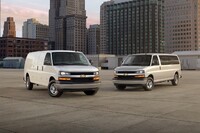It's a rare thing to get a chance to review a 29-year-old brand-new vehicle. The 2025 Chevy Express van is almost exactly that because it is basically the same today as it was back in 1996 — and that's a good thing, if you're less than enthused about what's happened to vehicles since then.
What It is
The Express is a full-size van built like they used to make 'em.
Meaning, it features body-on-frame (rather than unibody) construction and rear-wheel drive rather than front-wheel drive. It also comes standard with a big (4.3-liter) V6 engine that is not augmented by a turbocharger, because it is big enough to not need the boost — and it can be optioned with much bigger (6.6-liter) V8. Equipped with the latter engine, the Express can pull up to 10,000 pounds, and even with just the V6, it can pull up to 7,100 pounds — more than most current midsize trucks and about twice as much as any new minivan.
The Express is also a minimalist rig in that it's just got space behind the two front seats. You can add seats — and carry as many as nine people — or configure it to carry cargo. The space can be converted into just about anything you can conceive, including living space. Many RV builders use the Express as the foundation for a motorhome, chiefly because of its sturdy underpinnings and reliable (because simple) V6 and V8 powertrains.
The Express comes in 2500 ($41,800 to start) and 3500 ($45,700) versions. Opting for the 6.6-liter V8 adds $3,505 to the bottom line and also gets you a heavy-duty towing package, tilt wheel and cruise control. Yes, the latter two amenities are not standard, something that harkens back to the mid-1990s when cruise control and a tilt wheel were considered luxury features.
What's New for 2025
Almost nothing. Excepting a few concessions to modernity such as available remote keyless entry, it's 1996 all over again.
What's Good
— Built like they used to make 'em.
— Almost infinitely configurable.
— Priced much more attractively than rival vans such as the Mercedes Sprinter, Ford Transit and Ram ProMaster.
What's Not So Good
— Much more expensive today than back in '96 — even accounting for inflation. Base price of the essentially identical Express back then was just over $24,000.
— No diesel engine option or all-wheel-drive option.
— Newer-design vans such as the Benz Sprinter offer more up-to-date amenities.
Under the Hood
The Express is available with either of two engines that would be familiar to anyone shopping for a vehicle back in '96. The first is GM's 4.3-liter V6, which is related to an oldie but a goodie. The original 4.3 was a simple, overhead valve, two-valve V6 that is basically a classic small-block Chevy V8 with six rather than eight cylinders. It has the same bore/stroke as the 350-cubic-inch (5.7-liter) V8 that Chevy made in the millions; it was known to be a 300,000-mile engine if you changed the oil regularly, and it can be serviced by almost anyone with basic hand tools and the ability to read a shop manual.
The current 4.3 is aluminum and has direct injection — so it's not quite '96 anymore under the hood. But it's still a big V6 and not a turbo four.
In the Express, the 4.3-liter V6 touts 276 horsepower. An eight-speed automatic is standard — and this is one of the few mechanical things that is different versus back in '96, when the Express used a four-speed automatic with just one (rather than multiple) overdrive gears. The government does not publish gas mileage figures for vehicles in this category but the eight-speed automatic probably enables the '25 to go a little farther on a gallon of gas than the '96.
A 6.6-liter V8 is available optionally. It touts 401 horsepower and ups the towing capacity of the Express to 10,000 pounds.
Both engines are simpler and so likely to be more long-term durable than the smaller/turbocharged engines in rivals such as the Benz Sprinter — which comes standard with a 2.0-liter turbodiesel four that makes just 170 horsepower — and the Chevy's optional 6.6-liter V8 is much stronger than the strongest engine available in rivals such as the Ford Transit (3.5-liter turbo V6, 310 horsepower).
Every Express is RWD. Some of the others in the class — such as the Ford Transit — are available with AWD.
On the Road
Driving the Express is a lot like driving a full-size SUV such as a Chevy Suburban in that both are about the same length except when you're driving the Express, it's like it's 1996 all over again. There's an ignition key you need to put into the lock (and turn) in order to start the engine. This is almost as time-travel-y as finding an ashtray in a new vehicle. There's also an instrument cluster — actual analog dials and needles — and there isn't an LCD touch screen. The only thing "digital" about the dash is the face of the stereo, which has a digital station-you're-on display rather than a dial and a needle (it's not 1976, after all).
All of this may be a welcome relief from the over-teched-ness of other, newer vehicles — including current-year full-size SUVs such as the Suburban. There is very little to distract from the task at hand. You turn the key, start the engine — pull the column shifter into Drive.
And just drive.
The "safety" and "driver assistance" stuff is minimal; just a few unobtrusive things such as a blind-spot monitor, lane departure warning and collision warning. None that actually interfere with your driving. The few systems on board can also be turned off. There's no automatic stop/start either.
You can even do a burnout if you want to. Just turn off the traction control, hold the brake, and load the torque converter by pressing down on the gas pedal until the rear tires begin to slip and smoke. There are those who will say this is juvenile, but it's an example of what used to be possible in vehicles that you were in control of. As opposed to vehicles that controlled you. So it's not so much about laying rubber as being able to if you wanted to.
Despite its size, it scoots. With the V8, this full-size van can get to 60 mph in about 8.7 seconds. That isn't slow for something this big — and the V8 has a nice muscle car sound to go along with it.
You will, of course, be taken back in time in some other ways. There's noticeably more road/wind and drivetrain noise within this new-old van, which you'd expect when you remember the design dates back 30 years plus. And — to be fair — the cavernous interior is a massive echo chamber. There are no rear seats (as it comes) and very little in the way of acoustic deadening because the walls are metal and so are the floors. The cabin quiets up a lot once you lay down some carpet, trim the walls and add seats — assuming you do.
If you don't, you can do some interesting things with the space available — about which more follows.
At the Curb
One of the things you can do with the Express that you can't do with any currently available full-size SUV, such as a Suburban, is load a motorcycle into the rear. Yes, you can.
I did.
It's possible to do that with the Express not only because the entire interior is open space behind the driver and front seat passenger's seats but also because the floor of the Express is much closer to the ground — because this is a van, not an SUV. Also, the rear doors open Dutch door style, which opens up the entirety of the interior.
Most people aren't going to use this van for transporting a motorcycle — but the point is, you could.
You can also do just about anything else you like with the blank slate you have before you. With four rows of seats — including the seats for the driver and front-seat passenger — you have seats for nine adults. In pretty much every three-row, full-size SUV on the market right now, the third row is a row for kids; nice to have, if you have them. But not so nice if you're an adult and have to sit back there.
You could also use the Express as the basis for an RV. Many people actually do this — not only because there's so much space to work with but because of this van's heavy-duty underpinnings. The same is true of other such vans, like the Benz Sprinter — but it's much more expensive and it has a Mercedes drivetrain. In other words, a much more expensive-to-service luxury vehicle drivetrain than the Chevy's utilitarian V6 and V8 drivetrains.
The major downside — if you're considering this van as potential for RV conversion — is that Chevy does not offer a factory high-roof version, as both Benz and Dodge do with their vans.
The Rest
As already related, this van comes stripped — with very few of the roster of what used to be considered optional luxury features that are now pretty much standard in everything new. Such as a stereo with more than just two speakers — which is what you get standard with the Express. You can opt for SiriusXM, though — as well as a (as in just one) USB port. A Bluetooth connection kit is $200 extra.
The Bottom Line
It's not exactly a DeLorean. But it does travel back in time!
Eric's latest book, "Doomed: Good Cars Gone Wrong!" will be available soon. To find out more about Eric and read his past columns, please visit the Creators Syndicate webpage at www.creators.com.
View the Chevy Express this week.







View Comments